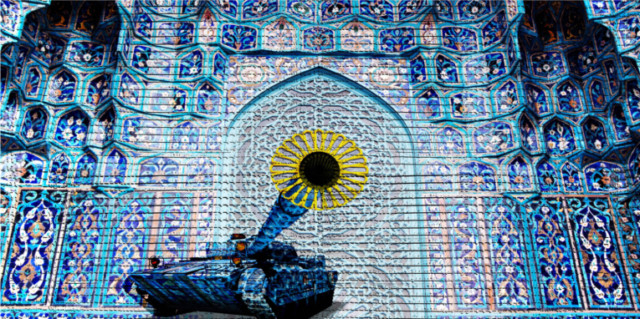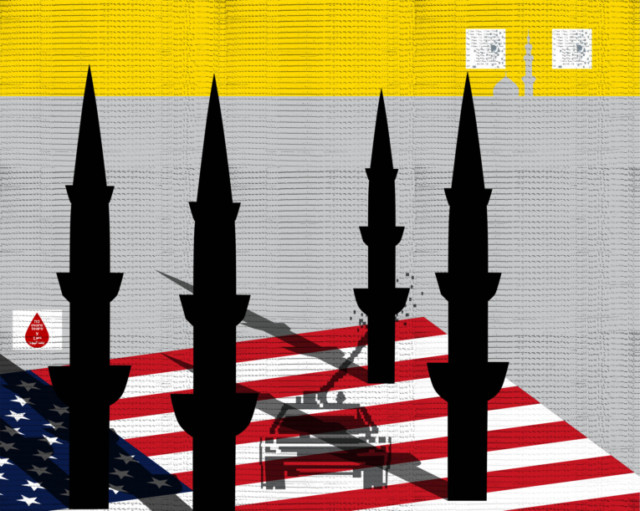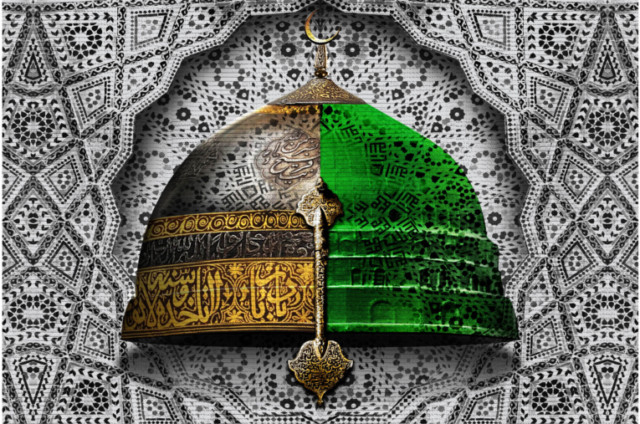
Saudi artist Abdul Nasser Gharem is known for his thought-provoking artworks that deal with sociopolitical issues in his country and the region. The artist, who is a Lieutenant-Colonel in the Saudi army, uses rubber stamps, concrete roadblocks and detour signs as metaphors for control and authority in his work. In his latest exhibition, “Al Sahwa” (The Awakening), Gharem investigates the recent history of the Islamic world to draw attention to the dangers of the growing interfaith conflict across the region, and to develop a new vision for a harmonious future.
The title of the show refers to the “Al Sahwa” movement that spread across the Kingdom of Saudi Arabia and the Middle East during the 1980s and 1990s. “I was in primary school when the ‘Al Sahwa’ began to form within the school setting. It brought changes such as a new dress code, a ban on girls attending school and television sets being thrown out of windows. Initially, participation in the group was an extracurricular activity but later its restrictive version of Islam began to shape the identity and growth of the students to a point where I felt that the movement was trying to change my ‘spiritual genes’,” he recounts.
“The terrible thing was that they used our marks to force us to participate, and the low grades I got because I refused created a lot of tension between me and my family. This affected me deeply and is still affecting me. And there must be many others who are similarly affected. So, I want to propose a new kind of awakening for the contemporary Middle East. This awakening must be facilitated via creativity, dialogue, exchange of knowledge, discourse on art and education, and an attitude of tolerance, so that we have a restoration of the real Islam, which believes in pluralism and diversity and is against extremism. I believe that art is the best language to create this awakening because it helps people and nations to communicate without the intervention of media, politicians or theocrats,” he adds.
The artist expresses his feelings strongly in “Hemisphere”, a monumental work created with rubber stamps, featuring a warrior’s helmet combined with the green dome of a mosque. The work depicts the grandeur of Islam, which stands for peace, as well as its misuse by elements that are inimical to a truly Islamic environment. “Due to the recent events in the region, today a soldier does not know what he is fighting for; and who the real enemy is,” Gharem says.
In “No More Tears”, Gharem has marked areas dominated by various Islamic sects on a map of the Mena region. The map refers to recent media reports about American plans to use religious conflict to divide the Muslim world. And the title is an ironic reference to the advertising slogan for a well-known American brand of baby shampoo.
The rubber stamps Gharem uses in his creations are specially made for each work and based on his research of the theme. A closer look at the inverted words on them reveals many humorous, insightful and interesting phrases that add another dimension to the artworks.
Other works in the show refer to the control exercised by the authorities over ordinary people in the name of religion. They include a large-size reproduction of the “Moujaz” stamp certifying Sharia compliance; and installations featuring “Detour” signs, and concrete roadblocks decorated with Islamic patterns.
“What made the Al Sahwa movement so strong at that time was the bureaucracy in the Middle East. My work refers to the bureaucratic procedures that make the life of ordinary people so complicated, block their dreams and kill their ambition. I am not for or against anybody. I stay away from politics and ideology and look at things only from a humanitarian perspective to find a vision for a better future,” Gharem says.
Jyoti Kalsi is an arts enthusiast based in Dubai.
“Al Sahwa” will run at Ayyam gllery, DIFC, until April 30.













